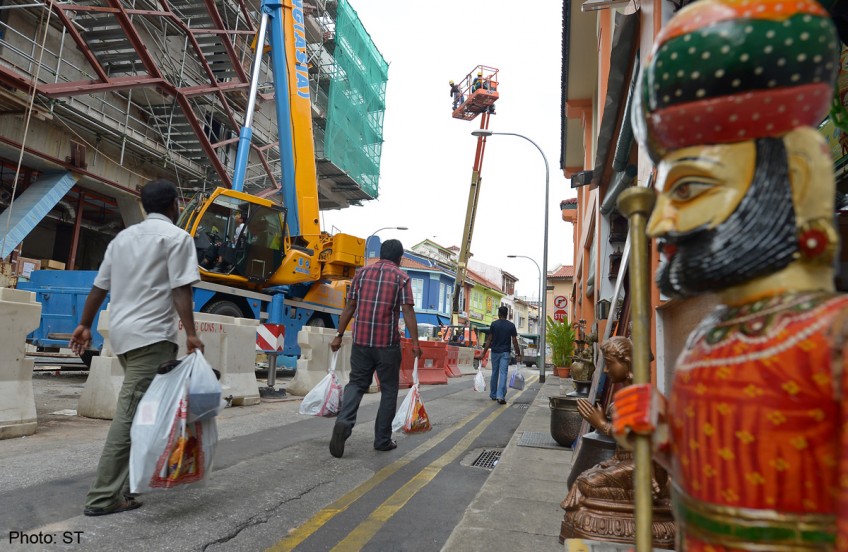Big plans for Little India lane

Away from the hubbub of Little India is a quiet, dusty 80m stretch known as Campbell Lane, usually ignored and frequently forgotten.
The Indian Heritage Centre (IHC) - a monolithic, concrete structure to be completed next year - dominates the street, deterring visitors with construction and noise.
Work on a long-talked-about pedestrian street will start later this month, adding to the dust and taking away tourist traffic.
But much about Campbell Lane lies in its future, as it hopes to transform from a mere artery that connects shoppers to Serangoon Road, to the heartbeat of Little India.
Bordered by Serangoon Road and Clive Street, Campbell Lane shares with adjacent Buffalo Road and nearby Kerbau Street the sweet scent of sandalwood and curry and an explosion of colour.
On one side of the street is the Little India Arcade, 1920s shophouses restored to a pastel palette in 1994. It is a winding network of 49 storefronts and curios kiosks, all of which must sell items deemed Indian in culture. This is determined by the Hindu Endowments Board, which operates the place.
The over-zealous curation can come across as kitschy, almost as ironic as the lane's namesake. Right in the middle of Little India is a street named after Sir Colin Campbell, the man who shut down a mutiny by Indian rebels in 1857.
The material possessions, supposed symbols of Indian culture, that shops like Padma hawk include wooden jewellery boxes encrusted with faux gems on a five-foot walkway, and plenty of gold-and-purple ornamental necklaces to fill the boxes with.
The 12-year-old Celebration of Arts has shelves of mojari, beautiful but impractical shoes with their curled toes, and made of camel leather. Another shop sells paintings featuring Rajasthani royal scenes and landscapes with grazing elephants.
Shopowners say the items are imported from all over: Thailand, China, Pakistan, and of course India. You won't see Singaporeans perusing the wares. Instead, the Japanese and Chinese tourists who trickle by are the biggest customers, though even they are a rare breed these days with the ongoing construction work.
On the other side of the lane, where the IHC will be, is half-a-century-old mainstay Jothi Store and Flower Shop.
"Jothi sells the A to Z of Indian needs," says Mr Siva Thyagarajan, 35, whose grandfather M. Rama Chandra built an empire that sells everything from "all 108 herbs you need for a Hindu housewarming" to musk mallow, cooling ointment to rub on your head.
The pious will have no trouble finding what they need in the five-storey shop; they can also run across to Jothi's Music Corner, which stocks a wide selection of Sanskrit devotional music.
And in an alley behind Jothi's are five men stringing marigold and rose garlands. Around 400 floral necklaces are shipped out to temples and weddings daily.
Operating on a smaller scale is neighbour Janehi Mahesh, 56. Hari Om Tailors focuses on tailored textiles but high rent has forced Mrs Mahesh to diversify and go into the florist trade.
Her make-shift flower cart spills out onto the street - space that she must struggle to create when the Urban Redevelopment Authority (URA) clears the road for renovation. The thought of a lengthy renovation frightens her: "If I had known, I wouldn't have signed the lease. My customers need the parking space too."
But the pedestrian street will come. In as early as 2001, the URA had considered making Campbell Lane off-limits to vehicles to make the area easier to explore on foot.
Such discussion resurfaced throughout 2006 to 2008, but fears about an overly commercialised street may have stalled plans.
"Shopkeepers were frightened this was going to end up like Chinatown," said Mr S. Gohulabalan, Little India Shopkeeper and Heritage Association vice-chairman.
But last December's riot in Little India finally set a 13-year-old idea in motion. URA group director Ler Seng Ann told the Committee of Inquiry last month the revamped street will "serve as a good gathering space".
By early next year, Campbell Lane's tarmac road will be tiled, with lamps bearing lotus motifs. It will be closed to traffic, but open to tourists eager to check out the $15 million heritage centre.
Some shopkeepers fear the new lane. Others anticipate a vibrant crowd. But despite the polarisation of these emotions, time has slowed on this sometimes desolate street.
A smattering of tourists and the occasional local wander the shops, their eyes taking in brass statues of Ganesh, embroidered Punjabi suits and henna paint.
The seemingly superficial exercise belies a peaceful slice of Little India on the cusp of something brighter.
rachelay@sph.com.sg
This article was published on April 11 in The Straits Times.
Get a copy of The Straits Times or go to straitstimes.com for more stories.